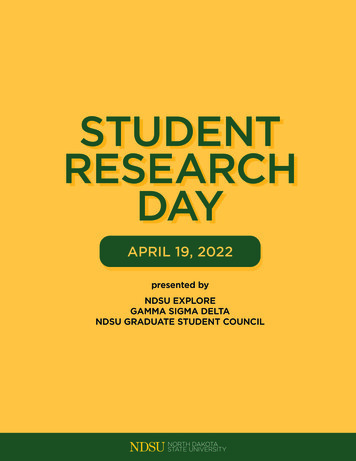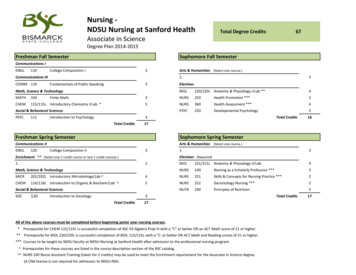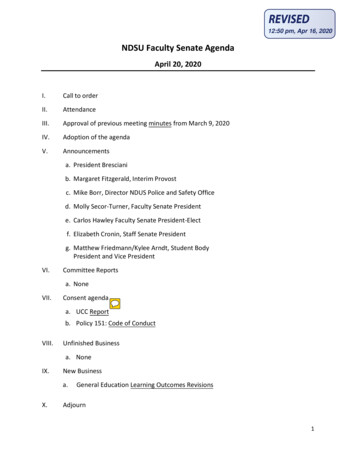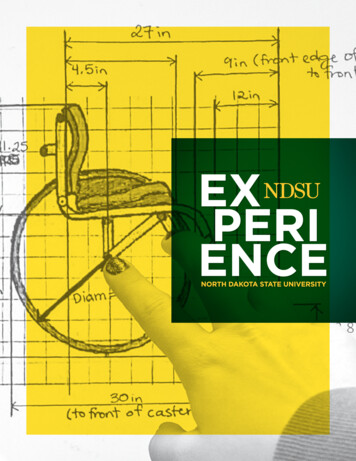
Transcription
STUDENTRESEARCHDAYAPRIL 19, 2022presented byNDSU EXPLOREGAMMA SIGMA DELTANDSU GRADUATE STUDENT COUNCIL
WELCOMEMessage from RCAWelcome to NDSU Student ResearchDay 2022, a collaborative event thatcombines our annual NDSU EXPLOREprogram with both the Graduate StudentCouncil and Gamma Sigma Deltaprograms. We are excited to bea part of this day celebrating NDSUstudent researchers.We have a long history at NDSU of both undergraduate and graduatestudents working side by side with faculty researchers andcontributing to many amazing discoveries. Many of these studentshave then continued the path of discovery and found their ownsuccess in academics, laboratories and the private sector. But nomatter where they end up, so many identify their student researchexperiences as important points in their development as scientistsand scholars.Today you can experience the smart and innovative work of thesestudents early in their careers and you’ll see firsthand what creativity,drive, focus and a healthy dose of curiosity can help a personaccomplish. The research you’ll hear about spans the many disciplineshere at NDSU, but rest assured, tomorrow’s discoveries are in goodhands with these students.Thank you for your support of Student Research Day and for yourcommitment to the success of the student presenters.Colleen M. Fitzgerald, PhDVice President, Office of Research and Creative ActivityMessage from Gamma Sigma Delta, NDSU ChapterResearch and Agriculture are pillarsof NDSU’s history; together, theseendeavors have made tremendouscontributions to the people of NorthDakota and beyond. This event includesanother pillar of success: our students.Gamma Sigma Delta, the Honor Societyof Agriculture, is pleased to welcome you to this student researchsymposium. Thank you for joining us today.Rebekah Oliver, PhDAssociate Professor of Practice, Plant SciencesPresident, Gamma Sigma Delta, NDSU ChapterMessage from Graduate Student CouncilWelcome to the Student Research Day2022. The Graduate Student Councilis thrilled to be a part of thiscollaboration with NDSU EXPLORE andGamma Sigma Delta: The Honor Societyof Agriculture. For GSC this year, wehave seen a record number ofregistrations for both oral and posterpresentations. This would not have beenpossible without the tremendous help we had from our partnerorganizations regarding the planning, advertising and executionof this event. A big thanks to them. Also, this indicates the level ofdedication and hard work the graduate students have been givingfor research at NDSU. We are elated to give them the platform toshowcase their excellent work.The GSC thanks the departments of plant sciences, mechanicalengineering, and industrial and manufacturing engineering for theirgenerous donations to help the finance this event. Thanks go to theGSC executives and co-chairs and other volunteers who helped makethis event a success. Finally, we would like to thank the GraduateSchool for giving us the support and funding the GSC every year,which enables us to participate in such initiatives.I sincerely hope that NDSU Student Research Day will be a milestonefor NDSU and will continue to happen. From this event, both theacademic and industry personnel of North Dakota will receive an ideaabout the research strength of NDSU, which I believe will open newdoors for research funding and collaboration in near future.Thank you.Raihan QuaderPresident, Graduate Student Council2
SCHEDULE9:30-11:30 a.m.Undergraduate Student Oral Presentationsand Poster SessionNDSU EXPLORE Showcase of Undergraduate Researchand Creative ActivityResearch Symposium of Gamma Sigma Delta:The Honor Society of Agriculture1-3 p.m.Graduate Student Oral Presentationsand Poster SessionResearch Symposium of Gamma Sigma Delta:The Honor Society of AgricultureResearch Symposium of the Graduate Student Council3:30-4:30 p.m.Presentation: Preparing to Apply to Graduate SchoolNeely Benton, NDSU Graduate School4:30-5:30 p.m.Awards ReceptionNDSU EXPLORE Showcase of Undergraduate Researchand Creative ActivityResearch Symposium of Gamma Sigma Delta:The Honor Society of AgricultureResearch Symposium of the Graduate Student Council3
PARTICIPANTSNDSU EXPLORE Showcaseof Undergraduate Researchand Creative ActivityResearch Symposium of GammaSigma Delta: The Honor Societyof AgricultureORAL PRESENTATIONS:Ryan Anderson, Civil EngineeringYasser Ayeva, Electrical EngineeringDalton Booth, PharmacyMark Delisi, PsychologyKaija Dockter, Hospitality and Tourism ManagementJoseph Ekstrom, PharmacyKira Eliason, Civil EngineeringCarly George, BiotechnologyGavin Mallott, Electrical EngineeringVictor Martinez, PharmacyMadeliene Nichols, Animal SciencesXavier Pahl, PharmacyRachel Voigt, Animal SciencesUNDERGRADUATE STUDENTORAL PRESENTATION:Madeliene Nichols, Animal SciencesGRADUATE STUDENT ORAL PRESENTATIONS:Natalie Acosta Castellanos, Animal SciencesMd Zahangir Alam, Plant SciencesAhmad Al-Amad, MicrobiologySamuel Bibby, Plant SciencesKerri Bochantin, Animal SciencesLennel Camuy-Vélez, MicrobiologyBethania Davila Ruiz, Animal SciencesBrady Goettl, Soil ScienceMaverick Guenther, Animal SciencesShivreet Kaur, Plant PathologyRobin Malik, Range ScienceMika Mzumara, HorticulturePOSTER PRESENTATIONS:Floyd Althoff, MusicMary Bailey, GeologyPaige Ballard, Human Development and Family ScienceCatherine Bunker, GeologyKatie Gerold, Mechanical EngineeringMia Haugan, MicrobiologyEmily Jackson, GeologyJake Jenson, Animal SciencesIsabella Jurgens, Animal SciencesHannah Khan, Biological SciencesMadison King, Health ServicesKyla Larson, AnthropologyGrace Loegering, MicrobiologyCarl Ludewig, GeologyBrianna Maddock, BiotechnologyShae Pfenning, AnthropologyGrace Rebel, AnthropologyBrooke Rothamer, Biological Sciences EducationJakob Sailer, Mechanical EngineeringAyden Schmidt, Electrical EngineeringKathleen Schmidt, MicrobiologyTanner Smith, Mechanical EngineeringSamantha Stueber, Biological SciencesTrevor Theurer, MicrobiologyNatalie Visich, BiotechnologyKirsten Warcup, Biological SciencesKaylee Weigel, MicrobiologyDanielle Wright, MicrobiologyUNDERGRADUATE STUDENTPOSTER PRESENTATIONS:Mia Haugan, MicrobiologyIsabella Jurgens, Animal SciencesGRADUATE STUDENT POSTER PRESENTATIONS:Lucas Alexandre Batista, Plant SciencesIbrahim Bello, Agricultural and Biosystems EngineeringAngela Johnson, Extension EducationHeymant Kaur, Cereal ScienceNirmala Subedi, Cereal ScienceAishwarya Suresh, Cereal ScienceMikayla Tabert, Plant SciencesRunhao Wang, Plant Sciences4
Research Symposium of theGraduate Student CouncilPOSTER PRESENTATIONS:Lucas Alexandre Batista, Plant SciencesKaitlynn Anderson, AnthropologyJuliana Antwi, Public HealthValentina Asiedu, Public HealthRebecca Aubart, PharmacyAnurag Banerjee, Pharmaceutical SciencesIbrahim Bello, Agricultural and Biosystems EngineeringNiyati Borkar, Pharmaceutical SciencesAshish Christopher, Plant ScienceAmirreza Daghighi, Biomedical EngineeringOmolola Eniodunmo, ChemistryShrinwanti Ghosh, Biological SciencesJesmin Jahan, Cellular and Molecular BiologyAngela Johnson, Extension EducationEmily Johnson, PsychologyAnas Karuth, Coatings and Polymeric MaterialsAchiya Khanam, Coatings and Polymeric MaterialsGarrett Levin, MicrobiologySekhar Mariappan Ajitha Kumari, Environmental andConservation ScienceMd Saimon Mia, Pharmaceutical SciencesTamanna Mim, Industrial Engineering and ManagementVimukthi Molligoda, Cereal ScienceTaofeek Mukaila, Environmental and Conservation ScienceVikneshwari Natarajan, Cellular and Molecular BiologySierra Nguyen, Public HealthTam Nguyen, Civil Engineering - Water ResourcesHeather North, Biological SciencesKelly Parker, Health Nutrition and Exercise Science Exercise/Nutrition ScienceJacob Pithan, Biological SciencesMd Mahbubar Rahman, Industrial and ManufacturingEngineeringBethany Roberton, EntomologyPrattasha Saha, Civil Engineering - StructuralSajib Sarkar, Construction ManagementJake Schumacher, MicrobiologyThomas Stach, ChemistryNirmala Subedi, Cereal ScienceAishwarya Suresh, Cereal ScienceJessica Syring, Animal SciencesBryce Van Vleet, Developmental ScienceRunhao Wang, Plant SciencesHaley Woods, ChemistryAaron Yang, Software EngineeringRose Yang, PharmacyORAL PRESENTATIONS:Natalie Acosta Castellanos, Animal SciencesMd Zahangir Alam, Plant SciencesAhmad Al-Amad, MicrobiologyLabiba Noshin Asha, Industrial and Manufacturing EngineeringSamuel Bibby, Plant SciencesKerri Bochantin, Animal SciencesLennel Camuy-Vélez, MicrobiologyEmma Chandler, Environmental and Conservation SciencePrantik Roy Chowdhury, Mechanical EngineeringAutumn Clark, Environmental and Conservation ScienceJustin Clarke, Range ScienceUrmi Das, MicrobiologyBethania Davila Ruiz, Animal SciencesSunil GC, Agricultural and Biosystems EngineeringAnuj Ghimire, Biological SciencesBijaya Ghimire, HorticultureBrady Goettl, Soil ScienceRyan Goke, CommunicationKrystal Grieger, ChemistryMaverick Guenther, Animal SciencesEmma Hawley, MicrobiologyPhat Huynh, Industrial and Manufacturing EngineeringMd Tariqul Islam, Cellular and Molecular BiologyMd Zahirul Islam, Mechanical EngineeringEllysa Johnson, Natural Resources ManagementNathaniel “Thanny” Johnson, DieteticsShivreet Kaur, Plant PathologyEsben Kjaer, Range ScienceRichard Lamptey, Pharmaceutical SciencesMagda Lopez Rodriguez, AnthropologyRobin Malik, Range ScienceMika Mzumara, HorticultureOlugbemiga Olatoye, Construction ManagementMd Ashif Islam Oni, Electrical and Computer EngineeringMd Atikur Rahman, Mechanical EngineeringMd Mirazur Rahman, Electrical and Computer EngineeringNitin Rai, Agricultural and Biosystems EngineeringJake Reinholz, Mechanical EngineeringKazi Sarjana Safain, Cellular and Molecular BiologyBiraj Saha, Civil Engineering - EnvironmentalRanjan Sapkota, Agricultural and Biosystems EngineeringByron Ward, Music - PerformanceHimani Yadav, Civil Engineering - Environmental5
ABSTRACTSUNDERGRADUATE STUDENT ABSTRACTSFloyd AlthoffMUSICFaculty mentor: Kyle Vanderburg, DMA –Challey School of MusicNDSU EXPLORE Showcase ofUndergraduate Research andCreative ActivityImplications of Rhythm, Meter,and Tempo in Samuel Barber’sHermit SongsRyan AndersonCIVIL ENGINEERINGFaculty mentor: Syeed Md Iskander, PhD Civil, Construction and EnvironmentalEngineeringNDSU EXPLORE Showcase ofUndergraduate Research andCreative ActivityNanoplastics in LandfillLeachate and Its EnvironmentalImplicationsIn 1953, Samuel Barber premiered his Hermit Songs with the iconic sopranoLeontyne Price and himself at the piano. This set is a collection of ten charming songswith texts written one thousand years ago by an assemblage of anonymous Irishmonks. Barber employs an intensely varied musical language throughout this work thatencapsulates the distinct characters of each poem. Whether it be a tongue and cheekode to one’s cat or a depiction of the elements of Earth tearing us asunder, one thingarises as the underpinning of each expression: Barber’s use of time. Time in musiccomprises three distinct aspects: rhythm, meter, and tempo. Tempo is the overarchingspeed of the music. It determines the quickness of each beat; whereas, meter determinesthe hierarchy of beats as well as each of their stresses and divisions. Lastly, rhythm isthe organization of music by the duration of each sound on a smaller scale. To analyzethe eccentric use of time in Samuel Barber’s Hermit Songs, I used a reductive style ofanalysis to reduce the music into diagrams of rhythm, meter, and tempo as well as howthese interacted with the musical character at that moment. Once the music is dissectedin such a way, what seems like an almost nonsensical aspect of Barber’s compositionstyle reveals recognizable patterns in rhythm, meaningful changes in meter, and anartful use of tempo to heighten the expression of each song.Plastics pollution is a major problem facing humanity. Global annual production ofplastics is predicted to reach 12 billion metric tons by 2050, and approximately 21 42% of generated plastic is stored in landfills. These landfilled plastics are broken downthrough biochemical reactions, having detrimental environmental and human healthimpacts. Plastic particles smaller than 100 nm are classified as nanoplastics, whichend up in landfill leachate and proliferate in the environment. To understand leachatenanoplastics pollution and their environmental impact, we are investigating a landfillleachate sample from Virginia. We first filtered the leachate through a 100 nm filterand divided our leachate into 8 different samples. After that, we performed chemicaloxidation on 4 samples to remove organics, reducing interference during nanoplastics identification and characterization. To remove the organics, we added 2 mL 30%hydrogen peroxide solution to 10 mL filtered leachate overnight at room temperature.The freeze and dry method was used to concentrate the other 4 samples. In addition,0.1 mL of diluted polystyrene solution (100 nm size) was added to 2 digested, and2 concentrated samples. Electron Microscopy was used to image these samplesto understand the occurrence of leachate nanoplastics. We are in the process ofperforming Fourier transform infrared spectroscopy (FTIR) to understand the composition of leachate nanoplastics. With the growing concern on plastics pollution, ourstudy will elucidate the potential of landfill leachate as carriers of nanoplastics and theirpotential environmental impacts.6
Yasser AyevaELECTRICAL ANDCOMPUTER ENGINEERINGGavin MallottELECTRICAL ANDCOMPUTER ENGINEERINGFaculty mentor: DharmakeerthiNawarathna, PhD - Electrical andComputer EngineeringNDSU EXPLORE Showcase ofUndergraduate Research andCreative ActivityMonitoring and Identificationof Microalgae StrainsThrough Electrical ImpedanceSpectroscopyMicroalgae is a microscopic eukaryote which closely resembles a plant cell andcan often be found in bodies of water. While microalgae contribute to the geochemical cycle, excessive growth can cause environmental issues such as eutrophication.Detection of algae in field conditions remains a pressing concern. This research is anattempt to develop a portable flow device for algal identification and monitoring in fieldconditions utilizing non-destructive electrical impedance spectroscopy (EIS). Electricalimpedance can be measured by applying a harmless level of voltage across the cells todetermine their unique impedance response. To do so with high accuracy and sensitivity we have used dielectrophoretic (DEP) force on microalgae cells and concentratedthem on the electrodes. We then used EIS to quantify the microalgae. To produce alarger DEP force on microalgae cells, it requires a large electric field gradient. Severalelectrode configurations were modeled using finite element modeling and determine anideal electrode configuration, ultimately resulting in an interdigitated microelectrodehaving an electric field gradient magnitude over 2x106 V2/m3 across most of the activeregion. Samples of microalgae cultures Chlorella vulgaris and Chlorella sorokinianawere obtained and a stock concentration was set to 2x107 cells per mL. The impedanceresponse of a series of dilutions was recorded for each sample, alongside color intensitymeasurements through image analysis. The impedance response was used to createan equivalent circuit model for the sample. In the next step, we will design a portabledevice that can measure the microalgae quantity using EIS.Keywords: Microalgae, chlorophyll, Chlorella vulgaris, Chlorella sorokiniana, Electricalimpedance spectroscopy (EIS), growth monitoring, microelectrode, CyanobacteriaYasser Ayeva, Shashi Bhushan, and Gavin MallottMary BaileyGEOLOGYFaculty mentor: Kenneth Lepper, PhD GeosciencesNDSU EXPLORE Showcase ofUndergraduate Research andCreative ActivityA closer look at the depositionalages for the upper and lowerCampbell shoreline of GlacialLake Agassiz in northwesternMinnesotaGlacial Lake Agassiz (GLA), the largest freshwater lake in North America’s history,existed for almost 4,000 years between the Pleistocene and Holocene geologic timeperiods. The formation of GLA was a result of the Red River Lobe of the Laurentideice sheet retreating during deglaciation from the Big Stone Moraine. GLA water levelchanges have formed several shorelines which are named Herman, Norcross, Tintah,and Campbell. Early interpretations of the Campbell water level separated the deposition of the ridge into an Upper and Lower expression by the Moorhead Low waterphase, however, recent research suggests that the Moorhead Low occurred during thedeposition of the Tintah. The study of GLA shoreline complexes is important to understanding the end to the last ice age in mid-continent North America, specifically theretreat of the Laurentide Ice sheet, and the effects of abrupt climate change during theQuaternary. The goal of this study was to determine the age of the Campbell strandlines mapped along the southern basin in Northwestern and evaluate how the resultscorrelate to the southern valley. Four samples were collected and dated via opticallystimulated luminescence (OSL) processes from each of the Campbell shorelines alonga 75 km transect, eight samples in total. The results allow a new interpretation that theCampbell shoreline elevation may have been occupied more than once.7
Paige BallardHUMAN DEVELOPMENTAND FAMILY SCIENCEFaculty mentor: Christi McGeorge, PhD Human Development andFamily ScienceNDSU EXPLORE Showcase ofUndergraduate Research andCreative ActivityTeachers and LGBQ Parents inthe Classroom: Implications foran Inclusive EnvironmentCatherine BunkerGEOLOGYFaculty mentor: Lydia Tackett, PhD GeosciencesNDSU EXPLORE Showcase ofUndergraduate Research andCreative ActivityNew Zealand TriassicBenthic ForaminiferaTeachers in primary and secondary schools need to be prepared to work with parentswith diverse identities. Little is known about how K-12 teachers are trained to workwith lesbian, gay, bisexual, and queer (LGBQ) parents, and how teachers incorporateLGBQ parents or identities into their classrooms. The existing research suggests thatteachers and schools struggle to create inclusive environments for LGBQ students, andteachers report that they have not received adequate training to work with studentswith a marginalized sexual orientation. Thus, it is quite possible that teachers are notwell trained to work with LGBQ parents and may unintentionally engage in exclusorybehaviors. This exploratory quantitative study sought to examine the type and level oftraining and education that K-12 teachers and undergraduate education students havereceived to work with LGBQ parents and their children, as well as the relationshipbetween their training and how they address marginalized sexual orientations in theirclassrooms. The data for this study came from 182 K-12 teachers and undergraduateeducation students and was collected using an online survey comprised of Likert scaleitems. The results of this study suggest that teachers and undergraduate educationstudents have received little training on working with LGBQ parents. The findings ofthis study provide implications for additional information that needs to be added toundergraduate education curriculums and topics for professional development sessionsfor teachers to create a more inclusive classroom environment for LGBQ parents andtheir children.The driving force behind this research is to learn more about the marine paleoenvironments of New Zealand during the Triassic Period (250 to 200 million years ago),and how foraminifera interacted in those environments. The goal of this project is tostudy and identify the benthic foraminifera (a type of shelled amoeba) of the UpperTriassic from New Zealand. By identifying the foraminifera using their shell shape toclassify them into a taxonomic family, we can then identify the possible environmentthe foraminifera inhabited, specifically whether the group lived on the seafloor orfloating in the ocean. Despite the ancient age of these fossils ( 220 million years old),we can determine their taxonomic lineage and interpret their lifemodes.8
Mark DelisiPSYCHOLOGYFaculty mentor: Mark Nawrot, PhD –PsychologyNDSU EXPLORE Showcase ofUndergraduate Research andCreative ActivityEfficacy of the saccadic eyemovement system in theperception of depth frommotion parallaxKaija DockterHOSPITALITY AND TOURISMMANAGEMENTFaculty mentors: Jeongdoo Park, PhD- Apparel, Merchandising, InteriorDesign and Hospitality Management;Kwangsoo Park, PhD - Apparel,Merchandising, Interior Design andHospitality ManagementNDSU EXPLORE Showcase ofUndergraduate Research andCreative ActivityPerceptions of and attitudetoward the application of AIservice robotsThe visual perception of objects’ position and depth in an environment can readilybe done using motion-based cues. To perceive depth, the visual motion of an object iscombined with the observer’s smooth slow-eye movements to disambiguate the depthand location of the object in the field. This information can typically be processedextraordinary quickly. Due to how fast this happens, we wondered whether the fast-eyemovement system could serve the same role as the smooth slow-eye movement systemfor the accurate perception of depth. To test this, we used computer-generated virtualstimuli translating laterally with varying presentation durations. If the visual systemreceives the proper information, these virtual stimuli could be perceived as having depth.Decreasing the presentation duration allows us to determine whether the system is functioning correctly or not. Results show that with slow eye movements observers requiredonly a brief presentation to accurately perceive depth. Presentation durations needed tobe much longer with fast eye movements. We interpret these results to mean that fast-eyemovements do not provide the necessary information to perceive the location and depthof an object as do smooth slow-eye movements. Thus, fast-eye movements do not play arole in the perception of depth using motion parallax. These results provide the basis ofexploration for the brain regions involved in motion parallax since the brain regions forfast and slow eye movement are closely abutting in the human brain.Artificial intelligent (AI) service robots have become an emerging trend in thelodging industry. This study compared managers’ and consumers’ thoughts on AIservice robots’ service capabilities, economic benefits, and security and safety concernsassociated with the adoption of service robots in the lodging industry. An onlinesurvey was administered to 50 managerial employees working for two hotel management companies in the Midwest and an online survey using Amazon Mturk wascompleted by 213 consumers in the United States of America. Descriptive, frequency,and test of differences analyses were conducted to analyze the data. The results revealedthat consumers overall view AI service robots in a more positive light than do themanagers. Consumers believe they would enjoy being served by an AI robot whilemanagers hold the perception that customers would rather be served by a serviceemployee. Consumers believe AI robots will be able to provide prompt, reliable,personalized, empathetic, and correct service, while managers believe service robotswill not be able to understand customers’ specific needs and give personalized service.Consumers were positive about the potential economic impacts (increased revenueand reduced operating costs) while managers were neither positive nor negative. Bothconsumers and managers want to feel confident there will be minimal technologyissues and safety risks associated with adoption. Overall, mean scores for attitude indicate that both consumers and managers have a favorable attitude toward the adoptionof AI service robots, though only consumers have a high intent to actually adoptthis technology.9
Joseph EkstromPHARMACYDalton BoothPHARMACYVictor MartinezPHARMACYXavier PahlPHARMACYFaculty mentor: Mark Dewey, PhD Pharmacy PracticeNDSU EXPLORE Showcase ofUndergraduate Research andCreative ActivitySchizophrenia effects 1 in 300 people and is present in 50% of mental hospitalpatients worldwide. It is a debilitating disease associated with high rates of suicide,occupational dysfunction, social dysfunction, and reduced life expectancy. It’s widelyaccepted that clozapine is the most effective medication for treatment resistant schizophrenia but has several side effects limiting use. One side effect is clozapine-inducedsialorrhea (CIS). There are no approved treatments for CIS as the mechanism iscurrently unknown. Salivation is primarily controlled by the M3 muscarinic receptor,but research suggests that several mechanisms contribute to CIS. Studies indicatethat clozapine’s metabolite, N-Desmethylclozapine, is an agonist of the M3 and M4receptors. Scientists theorize that stimulation of the salivary glands and resultingsialorrhea is due to the agonism of these receptors. Tropicamide is a M3 and M4receptor antagonist, but is not currently formulated for localized use in the mouth. It’sbeen successfully used for off-label CIS treatment. We propose tropicamide sublingualtablets to promote localized absorption and antagonism of the M4, and M3 receptors inthe salivary glands for the treatment of CIS.Exploring SublingualTropicamide for ClozapineInduced SialorrheaKira EliasonCIVIL ENGINEERINGFaculty mentor: Syeed Md Iskander,PhD - Civil, Construction andEnvironmental EngineeringNDSU EXPLORE Showcase ofUndergraduate Research andCreative ActivityLong-Term Monitoring of MetalConcentration in SouthernCalifornia Sea BeachesIncreased usage of metals in industries such as electronics, medical, and vehicleshave made finding alternative sources of metals imperative. Over the course of twoyears, sand samples were collected from 11 Southern Californian beaches for metalanalysis. The beaches are Laguna Beach, Newport Beach, Huntington Beach, SealBeach, Hermosa Beach, Manhattan Beach, Dockweiler Beach, Venice Beach, SantaMonica Beach, Malibu Pier Beach, and Point Dume Beach. After separating the metalsfrom the sand samples using a strong magnet, strong acids such as hydrochloricacid, nitric acid, and hydrogen peroxide were used to digest the metals. The digestedsolution was analyzed using the Inductively coupled plasma mass spectrometry (ICPMS). Preliminary results showed high levels of iron, titanium, and manganese in thedissolved solution. These results indicate that sand may be a viable source of metals forrecovery in the future.10
Carly GeorgeBIOTECHNOLOGYFaculty mentors: Gongjun Shi, PhD Plant Pathology; Zhaohui Liu, PhD Plant PathologyNDSU EXPLORE Showcase ofUndergraduate Research andCreative ActivityGenetic Mapping for NewVirulence Gene in PyrenophoraTritici-RepentisKatie GeroldMECHANICAL ENGINEERINGFaculty mentors: Chad Ulven, PhD Mechanical Engineering; Ali Amiri,PhD - Mechanical EngineeringNDSU EXPLORE Showcase ofUndergraduate Research andCreative ActivityUV Resistance andWeatherability of BiopolymersProblem Statement: To conduct genetic mapping of a virulence gene in tan spotpathogen, Pyrenophora tritici-repentis. Ptr is the causal agent to cause tan spot diseaseon wheat. Understanding the mechanism of how this pathogen causes disease willgreatly benefit our control and management of this disease.Research objective: This study will focus on genetic mapping of the virulence gene tocause disease in Ptr, which lay the foundation for further cloning and characterizing ofthe virulence gene.Research methodology:1.Pathogen and plant materials. Our lab has created a virulence segregating population between three races of Ptr. Differential lines (ARcrossB10, 86124, DW5).2. Population genotyping: SSR and STARP markers will be designed according to theavailable genome sequence of Ptr. PCR will be conducted with the designed markersand each individual isolate will be amplified with polymorphic primers.3. Linkage map construction: Software Mapdisto will be deployed.4. Tan spot resistance evaluation: Condia spore collection and inoculation will beconducted according to reference. 2-week-old plants will be inoculated and reactiontypes will be scored 7 days post inoculation.5. QTL analysis: Qgene programming will be used for QTL analysis.Results: 480 TCAP durum, 280 T. dicocum, and 192 T. dicoccoides populations werescreened for different reactions among the three pathogens. In the future, 120 progenies from each cross of the three pathogens will be screened on the above differentiallines.Implications: This study will discover more virulence alleles which will help managethis pathogen in the long run.Due to the advantages of natural fibers/fillers over synthetic or mineral counterparts,they have been the center of attention for the past couple of decades. Incorporatingnatural fillers into commonly used plastics such as polypropylene or polyethylenecan increase materials sustainability and reduce their carbon footprint by increasingtheir bio content. However, there are challenges to overcome before these biopolymers become more widespread in the advanced structural applications. One of thesechallenges is degradation due to exposure to weather (UV, moisture and heat). In thisstudy, a couple of different additives have been compounded into biopolymers, in orderto explored their effect on improving weather and UV resistance of these bioplastics.Results of this study provided insight into treatment of bioplastics for improved properties to endure and withstand harsh weather conditions (moisture, heat and UV).Katie Gerold, Abigail Henderson, Chad Ulven, and Ali Amiri11
Mia HauganMICROBIOLOGYGrace LoegeringMICROBIOLOGYNatalie VisichMICROBIOLOGYFaculty mentor: Barney Geddes, PhD Microbiological SciencesNDSU EXPLORE Showcase ofUndergraduate Research andCreative ActivityResearch Symposium of GammaSigma Delta: The Honor Societyof AgricultureEstimation of GenotypicDiversity for Rhizobiumleguminosarum IsolatesThroughout the State ofNorth DakotaEmily JacksonGEOLOGYFaculty mentor: Lydia
Kaylee Weigel, Microbiology Danielle Wright, Microbiology Research Symposium of Gamma Sigma Delta: The Honor Society of Agriculture UNDERGRADUATE STUDENT ORAL PRESENTATION: Madeliene Nichols, Animal Sciences GRADUATE STUDENT ORAL PRESENTATIONS: Natalie Acosta Castellanos, Animal Sciences Md Zahangir Alam, Plant Sciences Ahmad Al-Amad, Microbiology


![Welcome [dashdiet.me]](/img/17/30-day-weight-loss-journal.jpg)







